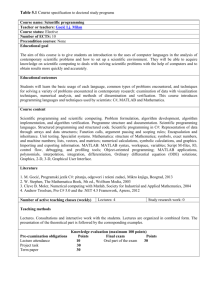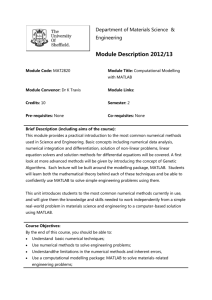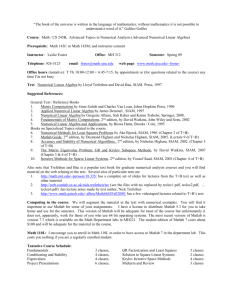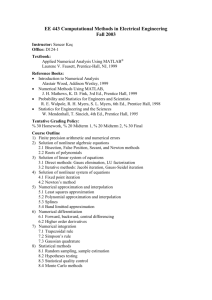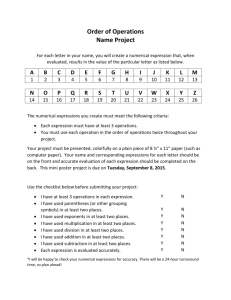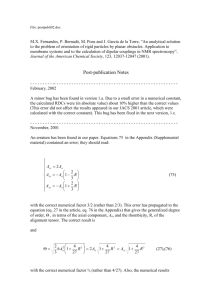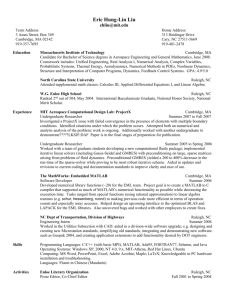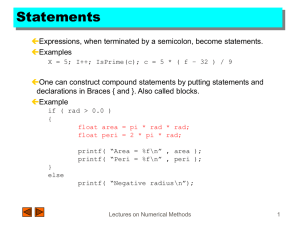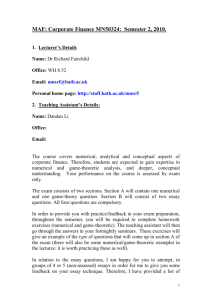Syllabus - Computer Science Home
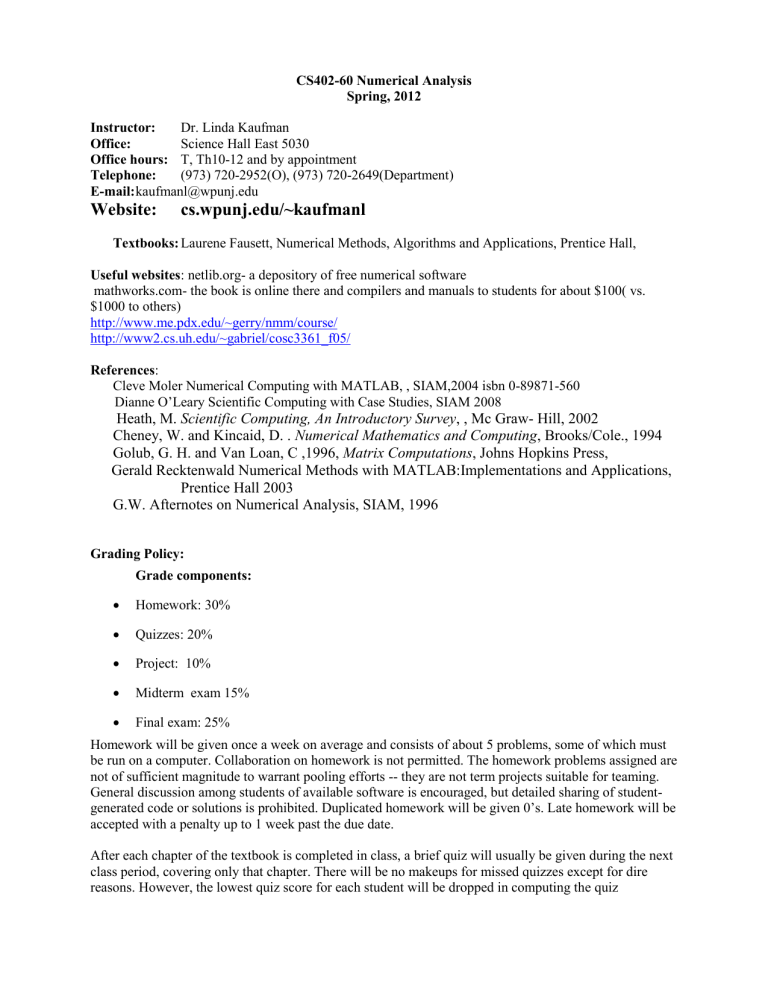
CS402-60 Numerical Analysis
Spring, 2012
Instructor: Dr. Linda Kaufman
Office: Science Hall East 5030
Office hours: T, Th10-12 and by appointment
Telephone: (973) 720-2952(O), (973) 720-2649(Department)
E-mail: kaufmanl@wpunj.edu
Website: cs.wpunj.edu/~kaufmanl
Textbooks: Laurene Fausett, Numerical Methods, Algorithms and Applications, Prentice Hall,
Useful websites : netlib.org- a depository of free numerical software
mathworks.com- the book is online there and compilers and manuals to students for about $100( vs.
$1000 to others) http://www.me.pdx.edu/~gerry/nmm/course/ http://www2.cs.uh.edu/~gabriel/cosc3361_f05/
References :
Cleve Moler Numerical Computing with MATLAB, , SIAM,2004 isbn 0-89871-560
Dianne O’Leary Scientific Computing with Case Studies, SIAM 2008
Heath, M. Scientific Computing, An Introductory Survey , , Mc Graw- Hill, 2002
Cheney, W. and Kincaid, D. . Numerical Mathematics and Computing , Brooks/Cole., 1994
Golub, G. H. and Van Loan, C ,1996, Matrix Computations , Johns Hopkins Press,
Gerald Recktenwald Numerical Methods with MATLAB:Implementations and Applications,
Prentice Hall 2003
G.W. Afternotes on Numerical Analysis, SIAM, 1996
Grading Policy:
Grade components:
Homework: 30%
Quizzes: 20%
Project: 10%
Midterm exam 15%
Final exam: 25%
Homework will be given once a week on average and consists of about 5 problems, some of which must be run on a computer. Collaboration on homework is not permitted. The homework problems assigned are not of sufficient magnitude to warrant pooling efforts -- they are not term projects suitable for teaming.
General discussion among students of available software is encouraged, but detailed sharing of studentgenerated code or solutions is prohibited. Duplicated homework will be given 0’s. Late homework will be accepted with a penalty up to 1 week past the due date.
After each chapter of the textbook is completed in class, a brief quiz will usually be given during the next class period, covering only that chapter. There will be no makeups for missed quizzes except for dire reasons. However, the lowest quiz score for each student will be dropped in computing the quiz
component of the overall grade for the course. Thus, the student should make every effort not to miss more than one quiz. Quizzes will be taken from the homework.
Programming Language and Software: Although it is not strictly required, MATLAB is strongly preferred because it is a very powerful for solving numerical problems and has built-in support for graphical output and it usually takes far less code and far less time to do homework in MATLAB than using other languages or software. It is a very easy language to learn.
Course Outline and very tentative schedule o Introduction(Chapter 1)- 3 lectures
Errors in Computation- Truncation error, roundoff error, forward error, backward error, sensitivity and conditioning, computer arithmetic, MATLAB
Computational resources-using the structure of the problem to decrease time and space requirements
Solving linear systems(Chapter 2)- 4 lectures
Gaussian elimination, condition numbers, iterative refinement
Cholesky factorization, banded systems, iterative techniques
Interpolation(chapter 3)-3 lectures
Polynomial- Lagrange formula, divided differences, splines
Finding roots and minimizing functions of 1 variable(chapter 4)-4 lectures
Fixed point iteration, bisection, secant technique, Newton’s method, golden secttion
Midterm
Solving Least Squares Problems(chapter 5)
Normal equations, QR, Conjugate gradient
Numerical Integration and Differentiation(chapter 6)-3 lectures
Quadrature formulae, extrapolation
Ordinary Differential Equations(chapter 7)-3 lectures
Taylor Series Methods, Runge Kuttas, stiffness, stability, multistep
Eigenvalue Problems(Chapter 10)-2 lectures
Symmetric problems, bisection, QR technique, reduction to tridiagonal form, Rayleigh quotient, inverse iteration
Nonlinear Function of Several variables(Notes) (2 lectures)
Important Dates
March 19-23 Spring Break
April 25 Projects due
1/24 last day for 100% refund, 50% withdrawal date, 2/29, last day for withdrawal3/14
No class Feb.20(university closed),
Class rules: No smoking. Cell phones should be turned off-I reserve the right to answer a ringing cell phone. Anyone who misses 7 classes unexcused will automatically fail the course.
Homework for the first few weeks:
Jan. 23:
Find and read on the web, Pitfalls in computation or why a math book isn’t enough by George Forsythe
For January 25:
1. Explain the distinction between forward error and backward error.
The sine function is given by the infinite series sin(x) = x- x^3/3! + x^5/5!-x^7/7!+
(a) What are the forward and backward errors if we approximate the sine function by using only the first term in the series, i.e. sin(x)=x for x=0.1, 0.5, and 1.0?
(b) What are the forward and backward errors if we approximate the sine function
by using only the first two term in the series, i.e. sin(x)=x-x^3/3! for x=0.1, 0.5, and 1.0?
2. Give an example of a number whose decimal representation is finite
but whose binary representation is not.
What are the approximate absolute and relative errors in approximating pi
by each of the following quantities
(a) 3
(b) 3.14
(c )22/7
3. P. 51 problem p1.19:
Do 3 ways to compute the roots of x 2 – 57x +1 to 4 digits
January 30:
1. p. 51 p.1.21
Find the integral from 0 to 2 of 1/(1+x 2 ) using the basic trapezoidal rule and the composite rule with h=1.
Do Richardson extrapolation.
2Explain why an alternating infinite series such as exp(x) = 1 + x + x*x/2 + x*x*x/3!+.. for x<0 is difficult to evaluate accurately in floating point arithmetic.
